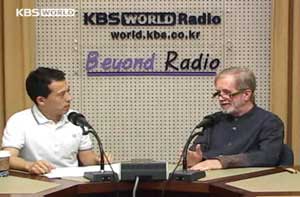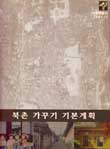
After six hundred years at the heart of Korean cultural and social life, Seoul's Kahoi Dong district, "the place where beauty gathers," is being relentlessly destroyed. Kahoi Dong is the last district in Seoul where there are whole streets of Hanoks, preserving the ambience of Seoul a century ago. These old homes are now being bulldozed to be replaced by two storey buildings built mainly of concrete and decorated with a topping of traditional-style architecture. Most recently, Kahoi-dong 31-93 and 31-94 were both demolished this March (2010). Kahoi-Dong is also part of Bukchon, "The Northen Village," a small area that lies between between two former royal palaces, both also fine examples of wooden architecture, the Kyongbok Palace or "Palace of Shining Happiness" and the Ch'angdok Palace or "Palace of Illustrious Virtue" (the latter was added to the UNESCO World Heritage List in 1997). Korea's traditional architecture Hanoks are single-storey buildings based on a cubical framework of interlocking wooden beams that rest on blocks of stone. Other materials used to complete the buildings are also wholly natural such as straw, mulberry paper, and clay. The materials and methods are fundamentally the same as those used to build the royal palaces of the Choson dynasty as well as old Buddhist temples, many of which have been lovingly restored in recent years. Until recently, the hanoks in Kahoi-Dong had survived the successive waves of re-development and re-building that have transformed most of the city. Yet even here pressures for redevelopment were gaining power. And so, Seoul City came to designate them as Local Cultural Assets on March 17, 1977, in an effort to protect them and preserve the area. The area has also been designated as the Korean-style House Preservation District and put under the special care of the City, according to the metropolitan government's web site Despite these measures, by 2000 only two streets remained entirely filled with hanoks giving a feel for how the district and much of Seoul had looked years ago. Elsewhere, apartment blocks and modern offices had already encroached. About this time, the Metropolitan government began to consider how best to retain what remained of the hanok village as part of plans for the continuing restoration of the historic sites of North Seoul. Towards the end of 2001, the Metropolitan government published detailed plans for the restoration and conservation of Bukchon using public money. The plans were based on a detailed architectural survey of most of the surviving hanok and aimed to restore the district to its former beauty. The government announced grants and low interest loans to assist hanok owners with this work and set about a variety of related projects including resurfacing roads, improving street lighting, removing utility poles, and providing signage to help tourists and other visitors explore the area. The Restoration Plan goes badly wrong From that point on, things went badly wrong. While the original plans can only be praised for their imagination and sensitivity towards the restoration of Korea's architectural heritage, what happened was the exact opposite. In our own street, ours is now the only surviving traditional hanok, all the rest have either been demolished or are now empty awaiting demolition. New buildings that have replaced hanoks have been financed partly via government grants and low interest loans. In one example, an owner was given a government grant of Won 30 million and an interest-free long term loan of Won 20 million for "Hanok Repair and Redecoration." This money was used to completely demolish a fine hanok and erect a modern two-storey building which has also been given a general business license to allow it operate under a number of categories, including as a restaurant. These arrangements were authorized by officials who assert " . . there are no proper regulations governing these matters." Is this a valid use of public money? Is this a responsible way to protect Korean culture? The new developments bring great profit to speculative developers who purchase the land at prices based on single storey dwellings and immediately re-sell it at far higher prices, exploiting loopholes in various regulations to erect two-storey buildings. As a result, Seoul's last hanok district is being destroyed; government grants to encourage preservation are being made available solely for demolition; and ordinary people are denied the chance to realize the fair value of their homes. Not the first time Kahoi-dong and Bukchon have enjoyed special status has historic districts of cultural importance since 1976. Although this is supposed to ensure the protection the districts hanoks, hanok numbers have declined each year. All the special plans and projects the metropolitan and local governments have launched have been accompanies by a decline in hanok numbers. Why so? The reason is quite simple, as the Bukchon plan explains, the laws and regulations to protect and preserve hanoks are simply not enforced; the protection plans are never implemented and the budgets associated with them are diverted to other activities. Korea loses contact with its own culture In every country, there are issues about what should be preserved from the past and what should be discarded. Every country tends to preserve its palaces, castles, and stately homes. In my own country, the UK and also in Europe, governments also preserves many more ordinary buildings such as farm buildings, ordinary houses, shops, and public houses. Some are preserved because of their beauty, some because of their construction techniques, some for the insights they provide into social history and the way people once lived. The preservation work involves public money, donations from business, and subscriptions from the general public. There is a broad consensus that this work is just as important as, say, preserving famous works of art because all these manifestations of human skill and creativity help define the culture and traditions of different peoples. It is so sad that these ideas are not well understood in Korea and that important decisions about what, in reality, is done to preserve Korean culture should be left to mid-level bureaucrats, small construction companies, and speculators. In some ways, there are special problems in Korea. During the Japanese occupation, there was a determined attempt to eradicate Korean culture. This was followed by the Korean war which splintered families, destroyed the social order, and caused immense physical destruction. Next came the period of military rule when individual liberties were suppressed as the country started to build a modern economy at breakneck speed. Perhaps it is not surprising that some Koreans have lost touch with their own traditions and culture as a result. Be that as it may, the decisions made by today's generation will determine whether anything will be left of Korea's distinctive architectural culture for their grandchildren to enjoy. The root cause of this and many of Korea's current problems is corruption. This is by no means a problem unique to South Korea. In some measure it exists in all countries. However, within the OECD, South Korea, sadly, is distinguished by ubiquitous, pervasive corruption that has become an integral part of government - from the offices of presidents to the lower level officials who staff regional and district offices. At least, this is the conclusion of Professors Doh Chull Shin and Chong Min Park, based on a research project into the lives of ordinary Korean citizens which they reported in a paper in the Sungkyun Journal of East Asian Studies in 2005. There is an enormous gulf between what city officials publicly proclaim and what they allow to happen in reality. The Bukchon Plan talks of the need to protect, preserve, and restore using authentic techniques and materials. City officials routinely approve wholesale demolition in order to erect new structures. Surely it is time to halt all the destruction of old buildings in Kahoi-dong, to demolish new buildings with illegal features, and for society as a whole to consider the fate of the district? Is it too much to expect that a country of Korea's economic power should find the time and the resources to preserve the last couple of short streets in the city that provide a window into ordinary life a century ago? In the UK, there are many examples of towns, districts, and buildings of a similar age to Kahoi-dong that are rigorously protected and preserved. The lesson from other countries is that such preservation work can attract tourism, enhance local culture, and make the modern urban environment a richer, more enjoyable place for all. This Website . . This purposes of this website are to document the changes that have been - and are - taking place in Kahoi-dong; to protest the wanton destruction; to argue for preservation and conservation; and to support the cultural heritage that goes hand in hand with traditional architecture. To these ends, the website documents events and places government documents relating to events in Kahoi-dong in the public domain for the public interest. We also hold a program of cultural events throughout the year - these are free and open to the public - and document these in the website. If you would like to help, or participate in this work, please contact us. Translators are especially welcome! Since it was launched as a single page in July 2005, kahoidong.com has received visitors from over 100 countries. Over 20,000 people have visited the home page while many more have visited other parts of the site. David Kilburn You can see a film of events in Kahoidong. Click Here. "We shape our buildings; thereafter they
shape us."
|
Indexes to pages in other languages
|
||||||||||||||||||||||||||||||||||||||||||||||||
Kahoidong.com launched in July 2005 after over a year of protests and complaints to the Civil Authorities
Contact us
The Campaign to save old Beijing
Konrad Fischer Architect: Restoration of old houses + Conservation of Historic Monuments





